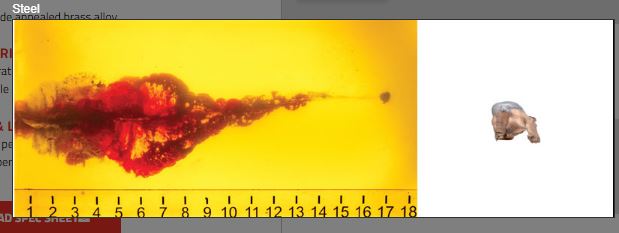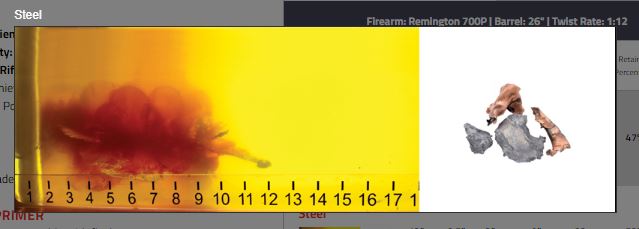I donít think many are saying that a 223 with heavy bullets is not doing a good enough job. I do think plenty are saying a bit more weight and some more velocity is better.
Welcome guest, is this your first visit? Create Account now to join.
Welcome to the NZ Hunting and Shooting Forums.
Search Forums
User Tag List
+ Reply to Thread
Results 286 to 300 of 397
Thread: A question for the doubters
-
02-09-2024, 02:33 PM #286Member

- Join Date
- Mar 2024
- Location
- Te anau
- Posts
- 189
-
-
02-09-2024, 02:34 PM #287Member

- Join Date
- Oct 2013
- Location
- Napier
- Posts
- 1,614
The thread title is "A question for the doubters" - we are now approaching 300 posts, to the OP - do you feel validated? There's been some good discussion sure, not sure if anything has been achieved.
People can and do choose to hunt with whatever takes their fancy - why would anyone care what anyone else hunts with....unless they have to share a hut or campsite with someone who wanks on relentlessly about how one calibre is better than the other?
-
02-09-2024, 02:41 PM #288Member

- Join Date
- Dec 2011
- Location
- NI
- Posts
- 13,574
Out beyond ideas of wrongdoing, and right-doing, there is a field. I will meet you there.
- Rumi
-
02-09-2024, 02:59 PM #289
-
02-09-2024, 07:08 PM #290Member

- Join Date
- May 2020
- Location
- West Coast
- Posts
- 1,193
-
02-09-2024, 07:45 PM #291
You know something really funny about your last two lines in green???? That is pretty much eggzachary what Philip Holden wrote in pack n rifle all those years ago...long before heavy pills were a commonly used thing.
75/15/10 black powder matters
-
02-09-2024, 08:18 PM #292
I used the old 196 grn in the old 8x57 , it was all you could get . Boat tail i think .
-
03-09-2024, 12:51 AM #293Member

- Join Date
- Sep 2022
- Location
- Upper Hutt
- Posts
- 658
-
03-09-2024, 10:13 AM #294
Can you be more specific about which part of this link you mean?
Not everyone seems to agree with you, Its definitely not my opinion
https://www.sporting-rifle.com/featu...-wound-cavity/
He states this, however there is no citation or explanation of why it is the most important, in his view
Others disagree that it is the most important factor in creating wounds.Everything that can be seen is related to the temporary cavity, which is possibly the most important concept in terminal ballistics.
He concludes that bullet construction is more important than energy figures in predicting wounds
In terms of stored energy, there is only 4ft/lb difference between the 20-grain and 17-grain at 100 yards, and virtually nothing at the muzzle. Yet, as is evident from the pictures, the effect in the gel is vastly different. This comes down to bullet construction. Almost the same amount of energy has been transferred to the gel, but each bullet has completed this at very different rates. If we look at the total depth penetrated (which has been averaged over a number of tests), we have a difference of 21cm. That means that the 20gr hollow point had more than double the penetration of the ballistic tip. On the flipside, the initial expansion of the B-Tip is very violent, and many times the diameter of the 20-grain bullet. In fact, there isn’t much between the 20-grain HP and a .22LR bullet with regard to the wound channel left behind.
He concludes that gel is a better medium that soap, as gel displays the important permanent cavity rather than the misleading temporary cavity
note - all lead bullets that have an exposed, hollow, or polymer tip are "fragmenting" bullets to some degree. Including bonded bullets -some of these will ~ 30% of weight through fragmentation.It is for this reason that using a plastically deforming ballistic material (such as soap) cannot tell the whole story. It is clear from the analysis of the gel that the difference in terminal effect in the first inch of the 17-grain bullet is vastly different to that of the 20-grain bullet. Although the soap shows a more delayed expansion, the true extent of the permanent wound profile is hidden. Having said that, there is a fixed relationship between what we see in the soap and the lasting result in tissue when we are looking at non-fragmenting bullets.
This part may be what you are referring to -
With the tissue relaxed back to its stable state, we are left with a permanent wound channel of destroyed tissue, and an area around this known as the extravasation zone. Unlike the permanent wound channel, which can be defined visually from the by the residual signature left behind in the ballistic gel, the extravasation zone shows no visual destruction. Here, the stretching imposed by the temporary cavity isn’t sufficient to tear tissue, but is enough to rupture sensitive parts of the body such as capillaries.
This is true. The size of this zone depends on the elasticity of the tissue. It appears that in the elastic tissues that we are generally target with front shoulder placement are not greatly affected, and the damage may not contribute much to immediate incapacitation or death - e.g. korac 2006, based on clinical observations from shooting pigs -
Within every gunshot wound three different zones can be distinguished: (a) the zone of direct trauma necrosis Ė it is immediately seen and can range from a few millimeters to a few centimeters; (b) the zone of massive quakes Ė a temporary cavity that depends on numerous ballistic characteristics. In several hours, irreversible changes manifesting as circulation problems,thrombosis and necrosis can develop in the tissue; and(c) the zone of molecular quake Ė it is caused by molecular movement in the tissue and involves the largest area. Clinically it is seen as an edema. The damaged tissue can fully recover.
Note that there are plenty of gel tests that compare bare gel to penetration through various intermediate media. The FBI standard requires clothing, steel, wallboard, plywood and autoglass.
This is 106gr ELDM in 6mm through 2 0.9mm sheets of steel, 75mm apart - much stronger than any bone in a deer. The wounds aren't spectacularly different to those produced with bare gel, except that expansion is initiated earlier.

and 308 155gr ELDM through steel

225 75gr TAP SBR (at low velocity - might look similar to a 300-400m impact from a normal length barrel)

Ultimately it seems like what we differ on, in any measurable concept, is the relative importance of the temporary cavity to immediate incapacitation or death. My observations from experience indicate that incapacitation and death appears satisfactory in the .223 with the bullets in question and my attempts to understand that by reviewing available data lead me to conclude that the temporary cavity isn't important. Your view is different. It may not be productive to explore it any further without additional evidence.
-
03-09-2024, 11:37 AM #295
Although I have no scientific evidence for this, so am unlikely to impress @gimp, (and my apologies if this has already been covered in the screeds of research that I haven't looked at) but I find it hard to believe that the "shock' of a bullet entering an animal does not have a big impact on its immediate incapacitation. You sometimes see on slow motion video a ripple run through the animal when it is hit, as the bullet releases energy into the animal. I liken it to being hit in the chest with a sledgehammer. In this case, because the impact is spread over a large area, no wound channel is created and there is no apparent tissue damage, but the blow will definitely incapacitate. As we have all probably experienced, being "winded" can be totally incapacitating, to the point of not being able to stand or breath. Usually within a few minutes we recover, but in the case of a terminal bullet wound, the animal will not. I don't believe the results of a ballistic gel test would have any way to relate this effect to the shooting of an animal because there is no permanent physical damage caused that can be observed and measured.
Experience. What you get just after you needed it.
-
03-09-2024, 11:54 AM #296Member

- Join Date
- Aug 2012
- Location
- Otago
- Posts
- 1,673
-
03-09-2024, 11:55 AM #297Member

- Join Date
- Feb 2020
- Location
- Scotland
- Posts
- 1,330
-
03-09-2024, 11:58 AM #298Member

- Join Date
- Apr 2019
- Location
- Tauranga
- Posts
- 834
That's why even lethally hit dear run off when Bow shot, minimal impact shock?
-
03-09-2024, 12:05 PM #299Member

- Join Date
- Mar 2024
- Location
- Te anau
- Posts
- 189
So more of everything is still better?
-
03-09-2024, 12:28 PM #300
Wound is less than the minimum size required for fast incapacitation with lung shot. Very small wound from a bow through lungs. No incapacitation from CNS damage in most cases. Bullets make bigger wounds. We don't know how small the minimum is for "satisfactory" results but it appears that an arrow wound is often below that minimum.
Similar Threads
-
6.5 question
By TimC in forum ShootingReplies: 20Last Post: 16-05-2023, 09:04 PM -
Question about BC
By dirkvanvuuren in forum Reloading and BallisticsReplies: 7Last Post: 14-08-2019, 06:58 PM -
Airgun doubters watch this. Your LR efforts are on notice! 1000y on a 2L softdrink
By Dead is better in forum ShootingReplies: 22Last Post: 11-11-2016, 09:50 PM -
Question
By Toby in forum Questions, Comments, Suggestions, Testing.Replies: 21Last Post: 20-03-2013, 06:00 PM
Tags for this Thread
Welcome to NZ Hunting and Shooting Forums! We see you're new here, or arn't logged in. Create an account, and Login for full access including our FREE BUY and SELL section Register NOW!!





 700Likes
700Likes LinkBack URL
LinkBack URL About LinkBacks
About LinkBacks



 Reply With Quote
Reply With Quote



Bookmarks